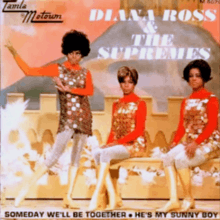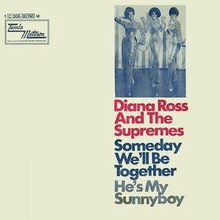Someday We'll Be Together
| "Someday We'll Be Together" | ||||
|---|---|---|---|---|
| Single by Johnny & Jackey | ||||
| Released | November 1961 | |||
| Format | Vinyl record (7" 45 RPM) | |||
| Recorded | 1961 | |||
| Genre | Doo-wop, rhythm and blues | |||
| Length | 3:34 | |||
| Label |
Tri-Phi 1005 | |||
| Writer(s) |
Johnny Bristol Jackey Beavers Harvey Fuqua | |||
| Producer(s) | Harvey Fuqua | |||
| Johnny & Jackey singles chronology | ||||
| ||||
| "Someday We'll Be Together" | |||||||||||||||
|---|---|---|---|---|---|---|---|---|---|---|---|---|---|---|---|
 | |||||||||||||||
| Single by Diana Ross & the Supremes | |||||||||||||||
| from the album Cream of the Crop | |||||||||||||||
| B-side | "He's My Sunny Boy" | ||||||||||||||
| Released | October 14, 1969 | ||||||||||||||
| Format | Vinyl record (7" 45 RPM) | ||||||||||||||
| Recorded | Hitsville U.S.A. (Studio A); June 13, 1969 + additional dates | ||||||||||||||
| Genre | Pop, soul | ||||||||||||||
| Length |
3:14 (original release) 3:33 (remastered) | ||||||||||||||
| Label |
Motown M 1156 | ||||||||||||||
| Producer(s) | Johnny Bristol | ||||||||||||||
| Diana Ross & the Supremes singles chronology | |||||||||||||||
| |||||||||||||||
| |||||||||||||||
| "Someday We'll Be Together" | ||||
|---|---|---|---|---|
| Single by Bill Anderson and Jan Howard | ||||
| from the album Bill & Jan (Or Jan & Bill) | ||||
| Released | June 1970 | |||
| Format | Vinyl record (7" 45 RPM) | |||
| Recorded | 1969 | |||
| Genre | Country | |||
| Label |
Decca Records 32689 | |||
| Producer(s) | Owen Bradley | |||
| Bill Anderson and Jan Howard singles chronology | ||||
| ||||
| "Someday We'll Be Together" | ||||
|---|---|---|---|---|
| Single by Diana Ross | ||||
| from the album Diana Extended | ||||
| Released | April 9, 1994 | |||
| Format | CD, Maxi-Single (PROMO) | |||
| Recorded | 1994 | |||
| Genre | Soul, Pop, Dance | |||
| Length |
3:04 (Radio Edit) 8:42 (Album Version) | |||
| Label | Motown Records | |||
| Producer(s) | Frankie Knuckles (Remixer) | |||
| Diana Ross singles chronology | ||||
| ||||
"Someday We'll Be Together" is a song written by Johnny Bristol, Jackey Beavers, and Harvey Fuqua and made popular as the last of twelve American number-one pop singles for Diana Ross & the Supremes on the Motown label. Although it was released as the final Supremes song featuring Diana Ross, who left the group for a solo career in January 1970, it was recorded as Ross' first solo single and Supremes members Mary Wilson and Cindy Birdsong do not sing on the recording. Both appear on the B-side, "He's My Sunny Boy."
The single topped the Billboard Hot 100 pop singles chart for one week. Reaching number-one on the American pop chart in the final 1969 issue of Billboard magazine (dated December 27),[1] the single was not only the final number-one in 12 chart-topping pop hits for The Supremes,[2] but it also holds the distinction of being the final American number-one hit of the 1960s.
Background
Original version
The song was written by Johnny Bristol, Jackey Beavers, and Harvey Fuqua in 1961; and Bristol and Beavers recorded the song together as "Johnny & Jackey" for the Tri-Phi label that same year. "Someday" was a moderate success in the Midwestern United States, but gained little notice in other venues.
Tri-Phi was purchased by Motown in the mid-1960s. Fuqua, Bristol, and Beavers all joined Berry Gordy's by-then famous record company, and "Someday We'll Be Together" became part of Motown's Jobete publishing catalog. Beavers soon departed for Chess Records, although both Bristol and Fuqua stayed on as songwriters and producers for the label.
Supremes version
In 1969, Bristol was preparing a cover version of "Someday We'll Be Together," to be recorded by Motown act Jr. Walker & the All-Stars. Bristol had already recorded the instrumental track and the background vocals by Maxine Waters and Julia Waters when Berry Gordy happened upon the tracks and heard them. Gordy thought that "Someday" would be a perfect first solo single for Diana Ross, who was making her long-expected exit from the Supremes at the time, and had Bristol sequester Ross into the studio to record the song.
Unable at first to get the vocal performance he desired from Diana Ross, Johnny Bristol decided to try something different: he would harmonize with Ross, helping her to get into the mood needed for the record. On the first take, the engineer accidentally recorded both Ross's vocal and Bristol's ad-libs. Bristol and arranger Wade Marcus liked the results, and Bristol had his vocal recorded alongside Ross' for the final version of the song. Bristol's ad-libs and words of encouragement to Ross can be heard in the background throughout the song. When Berry Gordy heard the completed song, he decided to release it as the final Diana Ross & the Supremes song. Ross' first solo single instead, released in early 1970, became "Reach Out and Touch (Somebody's Hand)."
While the explicit subject of the song was that of Ross comforting a long-distance lover, "Someday We'll Be Together" allowed for a number of other implications such that Ross and bandmates Mary Wilson and Cindy Birdsong would one day "be together." Further, in concert, Ross would suggest that "someday, we'll be together" in regard to contemporary troubles like civil rights and the ongoing demonstrations and protests against the Vietnam War.
Release
"Someday We'll Be Together" was included on the final Diana Ross & the Supremes album, Cream of the Crop. The song was a United States number-one hit on both the Billboard Hot 100 popular singles chart and the R&B singles charts, as well as charting in the top twenty at number 13 on the UK Singles Chart.[3] It also peaked on the Netherlands' MegaCharts at #19 in 1970. "Someday's" B-side, "He's My Sunny Boy," was recorded by Ross, Wilson, and Birdsong for the Love Child album in 1968 and written and produced by Smokey Robinson.
"Someday" charted at number-one on the Billboard Hot 100 popular singles chart for one week, on December 27, 1969. It also charted at number-one on the Billboard R&B Singles chart for four weeks, from December 13, 1969 to January 3, 1970. "Someday We'll Be Together" therefore appeared in Billboard as both the final Hot 100 and R&B number-one of the 1960s, and as the first R&B number-one of the 1970s.[4]
Notable live performances
The girl group made their final of several performances throughout the decade with Diana Ross singing lead on the 1960s decennial finale of The Ed Sullivan Show that aired live Sunday, December 21, 1969 on CBS.[5]
"Someday We'll Be Together" was the final number at Diana Ross & the Supremes' farewell concert on January 14, 1970 at the Frontier Hotel in Las Vegas. After the completion of the show, Jean Terrell was presented onstage to the audience as Diana Ross' replacement (alongside Wilson and Birdsong.) Thus "Diana Ross & the Supremes" officially split apart, becoming "Diana Ross" (the solo act) and "The Supremes" (the group).
Ross reunited with Wilson and Birdsong in 1983, performing the single for the Motown 25: Yesterday, Today, Forever television special. However this performance was marred by lingering hostility between Ross and Wilson, which Motown insiders report resulted in Ross shoving Wilson out of her way during the on-stage performance. A heavily edited version of this performance was released on the DVD of Motown 25.
Other cover versions
Bill Anderson and Jan Howard recorded a cover version for the country music market. Their version peaked at #4 on Billboard magazine's Hot Country Singles chart in the summer of 1970. Another cover, credited to the "already-defunct" group (and fellow Motown act) The Marvelettes, was released in 1970 as well, as a track to the group's final album The Return of the Marvelettes. As with the Supremes version, lead vocalist Wanda Young Rogers was the only group member to sing on the track, with The Andantes used as backing vocalists.
In 1992, Janet Jackson sampled the opening riff on her hit song "If" from the 1993 album janet. That same year Diana Ross released a remixed version by legendary DJ Frankie Knuckles. This single peaked at #7 on the Billboard Hot Dance Club Songs.
Amber Riley covered the song in 2015 for Glee's final episode "Dreams Come True".
Other cover versions included those by rock artist Vonda Shepard, Scottish pop singer Jimmy Somerville, orchestra leader Bert Kaempfert, and country singer Lorrie Morgan.
Personnel
Johnny & Jackey version
- Vocals by Johnny Bristol and Jackey Beavers
- Instrumentation by Various
Diana Ross & the Supremes version
- Lead vocals by Diana Ross
- Background vocals by Merry Clayton, Maxine Waters, and Julia Waters
- Male backing vocals by Johnny Bristol
- Instrumentation by The Funk Brothers and the Detroit Symphony Orchestra
- Arranged by Wade Marcus
Bill Anderson and Jan Howard version
- Vocals by Bill Anderson and Jan Howard
- Instrumentation by various instrumentalists
The Marvelettes version
- Lead vocals by Wanda Young Rogers
- Background vocals by The Andantes: Jackie Hicks, Marlene Barrow, and Louvain Demps
- Instrumentation by The Funk Brothers and the Detroit Symphony Orchestra
Track listing
Supremes version
- 7" single (14 October 1969) (North America/United Kingdom)
- "Someday We'll Be Together" – 3:14
- "He's My Sunny Boy" – 2:18
Chart history
Supremes version
|
Year-end charts
|
| Preceded by "Leaving on a Jet Plane" by Peter, Paul and Mary |
Billboard Hot 100 number one single (Supremes version) December 27, 1969 |
Succeeded by "Raindrops Keep Fallin' on My Head" by B. J. Thomas |
| Preceded by "Baby, I'm for Real" by The Originals |
Billboard's Best Selling Soul Singles number one single (Supremes version) December 13, 1969 - January 3, 1970 |
Succeeded by "I Want You Back" by The Jackson 5 |
See also
- List of Hot 100 number-one singles of 1969 (U.S.)
- List of number-one R&B singles of 1969 (U.S.)
- List of number-one R&B singles of 1970 (U.S.)
Bibliography
- Posner, Gerald (2002). Motown : Music, Money, Sex, and Power. New York: Random House. ISBN 0-375-50062-6.
- Wilson, Mary and Romanowski, Patricia (1986, 1990, 2000). Dreamgirl & Supreme Faith: My Life as a Supreme. New York: Cooper Square Publishers. ISBN 0-8154-1000-X.
- Whitburn, Joel, "Top Country Songs: 1944-2005," 2006.
References
- ↑ "Billboard Hot 100". Billboard. Nielsen Company. 81 (52): 44. 1969. Retrieved 10 May 2011.
- ↑ Bronson, Fred: The Billboard Book of Number 1 Hits, page 265. Billboard Books, 2003.
- ↑ Chart Stats - Diana Ross and the Supremes - Someday We'll Be Together, retrieved 27 March 2010
- ↑ Whitburn, Joel (2004). Top R&B/Hip-Hop Singles: 1942-2004. Record Research. p. 558.
- ↑ Guests: Diana Ross & the Supremes (21 December 1969). "The Singing, Soulful Sixties". The Ed Sullivan Show. Season 23. Episode 13. New York City. CBS. WCBS.
- ↑ Joel Whitburn's Top Pop Singles 1955-2002
- ↑
- ↑ "Image : RPM Weekly - Library and Archives Canada". Bac-lac.gc.ca. Retrieved 2016-09-26.
- ↑ "Top 100 Hits of 1969/Top 100 Songs of 1969". Musicoutfitters.com. Retrieved 2016-09-26.
- ↑ "1969: The Top 100 Soul/R&B Singles". Rate Your Music. Retrieved 2016-09-26.
- ↑ "Item Display - RPM - Library and Archives Canada". collectionscanada.gc.ca.
